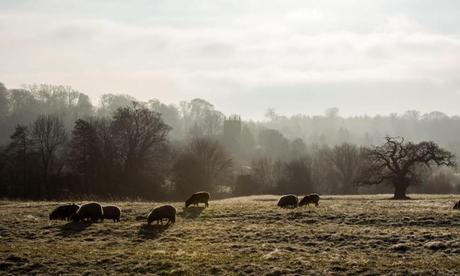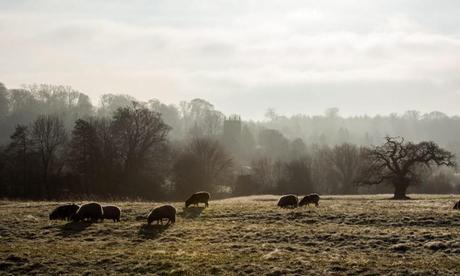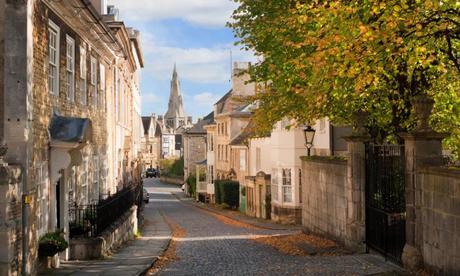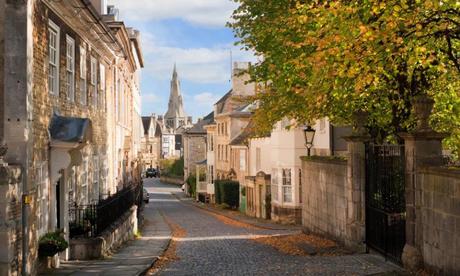The eight milkmaids have hunkered down in the Elizabeth Salon - or so it seems - leaving a pastel tower of buckets, cows and three-legged stools beneath the ornately painted ceiling. Next door, seven sculptural swans swim through a beautiful silver centerpiece above a large banquet table, while six life-size geese have laid Fabergé-esque eggs in sparkling nests with bullrush edges.
Charlotte Lloyd Webber, who decorates Bamburgh Castle, Northumberland, and Castle Howard, North Yorkshire, has created a beautifully theatrical 12 Days of Christmas here at Belvoir Castle (pronounced 'beaver'). The display includes more than 100 trees and thousands of baubles; the five gold rings are shaped like a large kinetic sculpture, which rotates above Belvoir's remarkable art collection (from £10/£19 for children/adults, belvoircastle.com).
Even without the seasonal bling, Belvoir is dripping in gold and brocade. Peacock motifs can be seen everywhere: on carpets, wood carvings and gilded stuccowork. Peacocks are part of the owners' family crest and reappear in the Aviary Tearoom, where the festive tea is a multi-tiered showstopper including gold and purple macarons and smoked cheddar sandwiches with homemade spiced pear chutney (£70 for two, plus entrance, belvoircastle .com).
I'm here for car-free seasonal fun, bracing walks, medieval churches and pints by the fire
As the Norman-French name suggests, the jewel in Belvoir's crown is the expansive view from the windows. On a clear day you can see the towers of Lincoln Cathedral on the horizon. South Kesteven is the corner of Lincolnshire and includes nearby Grantham and Stamford with its honey stone walls. It's tailor-made for a winter holiday, with towns and villages that can feel like a Christmas set from an imaginary Disney version of England. Grantham also has fast, frequent trains, so I'm here for car-free seasonal cheer, bracing walks, medieval churches and pints by the fire.
The story continues
This morning's train ran from Peterborough to Grantham in 20 minutes. Getting from the station to Belvoir without a car is more difficult. I booked a demand-side minibus through Callconnect, which connects busless villages in Lincolnshire. The service is rolling out an app, but I had to call the busy helpline to find a spot. Once booked, the journey is trackable and, as with regular buses, fares are capped at £2.


I could have used this service to get back from Belvoir, but the golden winter sun tempts me to walk the few miles to Woolsthorpe near Belvoir and take the 9 bus instead. The walk is idyllic and offers fairytale views across the sheep-dotted Capability Brown park to the hilltop castle. After enjoying a ginger ale at the Checkers Inn, I wait at the stop and see the bus ominously disappear from the tracking map on the bustimes.org website. I end up hitching a ride with a passing van.
Back in Grantham, there's just time to admire the towering St. Wulfram Church with its dramatic blue-and-gold interior before catching my train. In Peterborough Cathedral, with its beautiful vaulted ceiling, light artists Luxmuralis are installing a seasonal son-et-lumière (£8/£6.50 adults/children, peterborough-cathedral.org.uk).
This corner of Lincolnshire is tailor-made for a winter holiday, with towns and villages that feel like a Christmas set from an imaginary Disney version of England
Bus 201 from Peterborough to Stamford stops at Barnack, where the village church has a Romanesque sculpture and Saxon tower, and the recently renovated Millstone pub has an open fireplace and gourmet menu. A few minutes' walk from here you'll find the Hills and Holes Nature Reserve, 20 hectares of hilly, biodiverse land that was once a medieval quarry. Creamy limestone known as Barnack rag was excavated here and used to build Cambridge colleges, as well as the cathedrals of Ely and Peterborough; blocks of stone were dragged to the river to be transported by barge. Now the grassy hollows are home to rare plants, including orchids and purple pasqueflowers that bloom around Easter. In November there are autumn gentians among the short-clipped grass, harebells nodding in the wind, and falling polished leaves on tall silver birches.
I'm staying at Stamford's William Cecil hotel. It is named after Elizabeth I's treasurer, who built Burghley House nearby. The hotel has two dozen luxury rooms next to a labyrinth of corridors and a grand wooden staircase (doubles from around £120 B&B, thewilliamcecil.co.uk). Burghley Park is on your doorstep and new walking trails are being developed. The next morning I wander past ancient trees and elegant neoclassical bridges. Another Capability Brown creation, the winding lake and artfully naturalized deer park surround an impressive Elizabethan manor house (deer park is free, burghley.co.uk).
This year, for the first time, Burghley will open the gardens during winter weekends. They are bright with berry bushes, heavy-headed dahlias and lipstick-pink cyclamen under coppery oaks. The Garden of Surprises is an ideal center for a cheerful walk; playful water features bubble between yellow kingcups and spin delicate metal leaves. There's also a mirror maze, misty grotto and interactive obelisks representing the elements (gardens £7.50/£9 for children/adults, burghley.co.uk).
Medieval Stamford was one of England's wealthiest towns and its streets are lined with beautiful old limestone buildings. Stamford escaped heavy industry and wartime bombing and has retained its coaching inns and Georgian houses.
The winter sun after a stormy night draws me back to the countryside. Callconnect offers transport to the pretty village of Easton on the Hill, but on my last day I choose to go there via the six-mile Four Counties walk from Stamford, which passes through Lincolnshire, Rutland, Northants and Cambridgeshire.


The paths are muddy and the A1 is noisy at times, but you do get views of Stamford's spire-strewn skyline. Redwings are spooked by yellow hedgerows, and the riverbanks are littered with sculptural seed heads: teasel, burdock and cow parsley. I walk through Stamford's Waterfurlong Gardens, a utopian allotment. The traditional orchard is home to 55 varieties of apple trees, including rarities such as Barnack Beauty, Lady's Delight and Nelson's Codlin. At the entrance there are notices advertising Secret Garden yoga, medicinal plant searches and strawberry plant exchanges.
Up a winding stone staircase in Easton's small 15th-century Priest's House (free, nationaltrust.org.uk) I find a museum of village life. Among the objects on display are a Neolithic tool and a millennium candle. There is a striped collection bag, a bristle scraper, a slate pickaxe and a pair of wooden skates. At All Saints Church, around the corner, I discover that the Edwardian rector Percy Hooson once skated from Cambridge to Ely and back (about 30 miles) in an afternoon.
Later, on the train from Stamford to Cambridge, I catch a glimpse of the River Cam, which last froze over in 1997. In one field, between March and Manea, a flock of more than fifty swans have gathered in a flat field of stalks. Shortly afterwards you will have a view of Ely Cathedral above the boats in the marina, opposite misty floodplains full of cows.
Transport was provided by Cross Country (advance singles Cambridge to Stamford from £10:50 amcrosscountrytrains.co.uk) and LNER (advance singles Grantham to Peterborough from £7.60, lner.co.uk). Accommodation was provided by William Cecil, Stamford (doubles from approximately £120 B&B, thewilliamcecil.co.uk) and Vale House Belvoir (doubles from £95 room only, belvoirestateholidays.com).